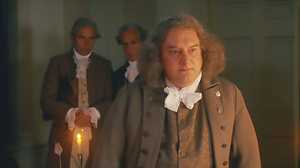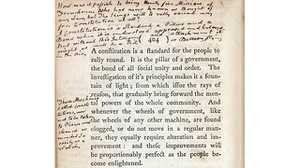Thomas Jefferson
Thomas Jefferson was a contradictory character: the Virginia aristocrat known as the "man of the people"; the president who simplified the office yet never denied himself a luxury; the slave owner who wrote passionately of freedom.

Comfortable Beginnings
Jefferson was born on Shadwell Plantation in Virginia on April 13, 1743. From his self-made father, Jefferson inherited 5,000 acres and 22 slaves. At age 28, he more than doubled his acreage and gained possession of some 150 slaves through his marriage to the widow Martha Wayles Skelton.
The Makings of a Leader
By all accounts, Jefferson was incomparably brilliant and insatiably curious. He attended the College of William and Mary and studied law, but his informal intellectual pursuits ranged to foreign languages, architecture, and agriculture. Politically, he first distinguished himself in the Virginia House of Burgesses (1769-1774) as an exceptional writer and a radical dedicated to American independence.

Defining Contradictions
In 1776, as a Virginia delegate to the Second Continental Congress, he composed the Declaration of Independence, which exposed a contradiction in his great mind: He proclaimed that "All men are created equal," yet owned more than 100 slaves. He would later propose to Congress that slavery be prohibited in newly acquired Western territories, yet he freed only two of his own slaves, in his will leaving the remainder -- nearly 200 chattel -- to be sold on the auction block.
Tragedy and a New Start
In the Virginia House of Delegates (1776-1779), Jefferson championed free public education, freedom of and from religion, and universal suffrage for white males. After reluctant, and ineffectual service as Virginia's wartime governor (1779-1781), he was done with politics. An accumulation of personal tragedy led him back. Early in their marriage, he and Martha had buried two infants. In 1781, four-month-old Lucy Elizabeth died. In 1782 his wife died from complications following the birth of a second Lucy Elizabeth, who died the next year. (Of six children, only two daughters remained.) As an antidote to his grief, Jefferson joined John Adams and Benjamin Franklin in Paris in 1784 on a commission to negotiate commercial treaties. He visited with, and entertained the Adamses, bonding deeply with both John and Abigail.
Venomous Politics
In 1789, President George Washington asked Jefferson to be his Secretary of State. Within weeks, the French revolution erupted, dividing Jefferson, who believed it was an extension of their own "glorious cause," and Vice President Adams, who was shocked by the bloody excesses of the Revolution. In the election of 1796 Adams narrowly defeated Jefferson. For the first and last time in American history, president and vice president represented different political parties, as Adams was a Federalist and Jefferson a Republican. The election of 1800 was even more sordid. The partisan press of both parties was venomous, but there was an important difference: Jefferson had secretly paid the Scottish "scandalmonger" James Callender to slander his opponent.
Reforming Regal Pomp
As president, Jefferson sought to do away with the regal pomp practiced by Washington and Adams. While personal frugality was anathema to Jefferson -- deeply in debt, he was an "irrepressible shopper" who lived beyond his means -- frugality in government was another matter. He eliminated internal taxes and paid down the national debt, drastically reducing the size of the military and closing embassies to cover tax cuts.

Irresistible Bargain
His greatest achievement as president, however, was the Louisiana Purchase. Jefferson, a defender of the Constitution and believer in a weak executive branch, doubted that the president had a constitutional right to purchase territory. Yet he did so, acquiring 828,000 square miles of western land from Napoleon for $15 million. At roughly four cents an acre, Jefferson had doubled the size of the country, or about $275 per acre in 2005 dollars.
A Leader Slips Away
At the end of his second term in 1809, Jefferson returned at long last to Monticello. In 1812 he and Adams resumed their friendship through a correspondence that lasted until their deaths. During his retirement, he also founded and designed the campus of the University of Virginia. Gravely ill by 1826, he began to slip in and out of consciousness on July 2, but held on until July 4 when he breathed his last, just hours before John Adams did the same in Massachusetts.







